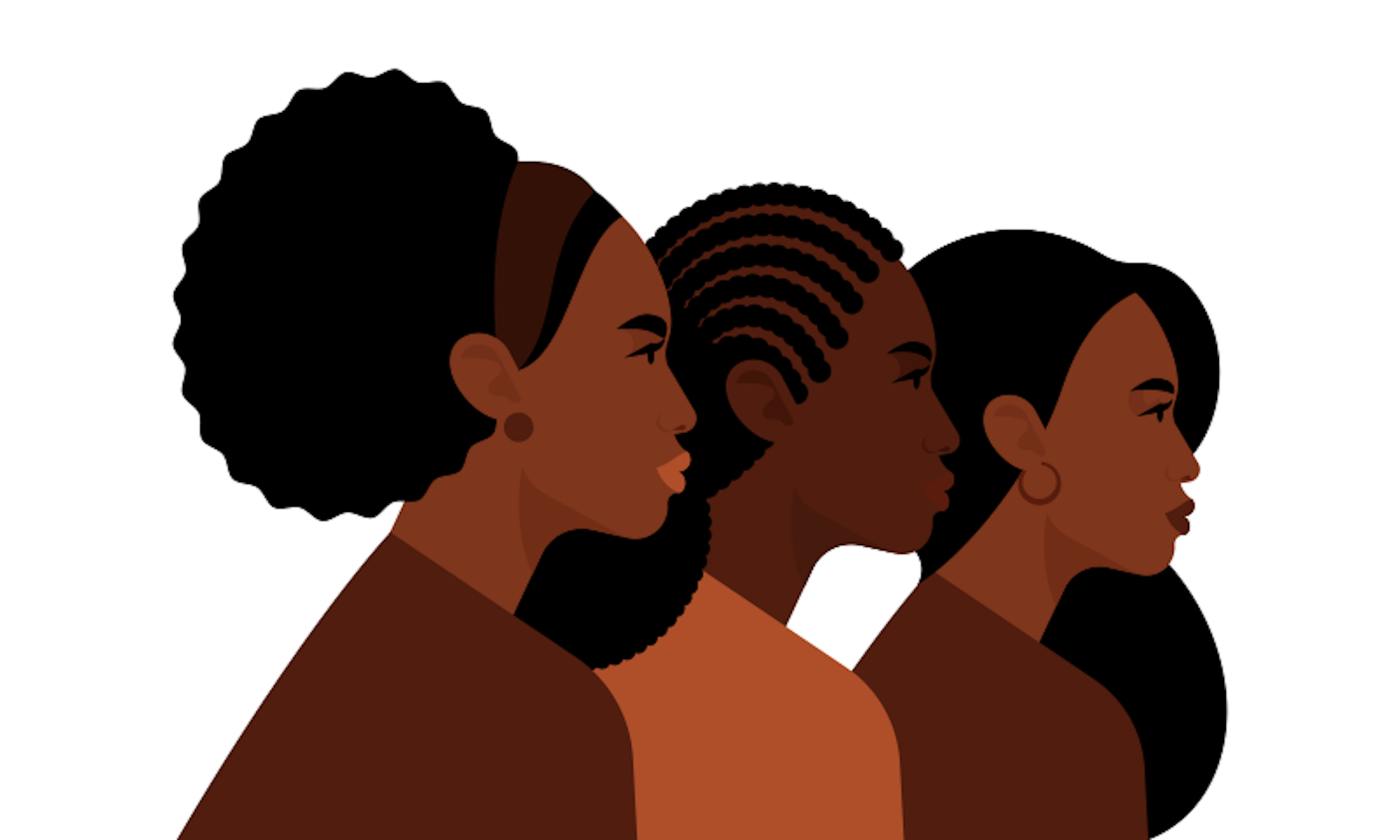In 2017, Jasmine Kwasa had family in town, and they wanted to see the lab where she spent so many of her hours. Kwasa was three years into her Ph.D. program at Boston University, studying how people with ADHD process sound. To monitor the brains of her subjects, she used electroencephalography (EEG), which relies on a snug-fitting electrode cap or individual electrodes pasted onto the scalp to record electric signals emanating from active neurons.
When Kwasa was showing her mom and cousin around the lab, her cousin asked if she could try out the EEG machine to see what her own brain waves looked like. Kwasa dismissed the idea out of hand. The EEG wouldn’t work well with her cousin’s hair type, she told her.
Biases are baked into neuroimaging technologies.
“My mom and cousin were horrified,” Kwasa says. It was only then that she realized EEG’s limited functionality with thick curly, kinky, and textured hair types—and her knee jerk response—might be a real problem, a source of exclusion in the field.
Kwasa, now a postdoctoral fellow at Carnegie Mellon University Neuroscience Institute, soon began working on a way to address the bias—the Sevo clip1, named for the Haitian-Creole word for brain. Originally invented by an undergraduate research assistant at the Neuroscience Institute, Arnelle Etienne, the Sevo clip holds electrodes against the scalp between cornrows braided to accommodate electrode placement, improving the flow of electrical charge from neuron to electrode. Kwasa, Etienne, and their colleagues are working to refine and commercialize the technology. But the problem, that hair type could exclude someone from a neuroscience study, is bigger than EEG—and bigger than laboratory research.
Biases against physical characteristics like dark skin and thick curly hair are baked into all of the major neuroimaging technologies, including EEG, functional near-infrared spectroscopy (fNIRS), and magnetic resonance imaging (MRI), as well as other neuroscience research methods used by scientists in Western countries. These phenotypes are common among Black people, which can lead to not just exclusion from research, but inaccurate readings at the time of clinical diagnosis.
When neuroimaging technologies were designed, the creators weren’t thinking “about what it would mean to apply [them] to a wide group of people that might have different features and different challenges,” says AZA Allsop, a psychiatry resident and researcher at Yale University, and coauthor of a recent Nature Neuroscience article that called out the numerous biases against non-white populations in neuroscience research.2 It doesn’t help that the academic neuroscience labs that use the technologies are overwhelmingly white.3
Electroencephalography is essential to a lot of basic neuroscience research as well as a mainstay in epilepsy diagnosis and a key tool for the diagnosis of many other neurological disorders. It’s also one of the most common technologies used in brain-machine interfacing, which is a critical component in medical devices used to help restore function in people with neurological injuries, like paralysis. Magnetic resonance imaging is also used to provide images of the brain for a wide range of clinical diagnoses, as well as to do basic research into brain structures and networks related to everything from psychedelic therapies for mental health issues to childhood development of math ability. More recently, researchers have turned to fNIRS as a cheaper and more portable alternative to MRI.
The shortcomings of neuroimaging became obvious to Termara Parker during the early days of her Ph.D. research at Yale University. Using EEG in her research on autism, she quickly noticed that most people volunteering for studies were white and Asian. “And then those who were Black tended to have a lot more restrictions,” she says. For example, they were told they couldn’t have their hair styled in braids or twists, says Parker. She has seen people come into the research lab with a natural hairstyle only to be turned away because the EEG cap wouldn’t fit over their hair. A similar problem arises with MRI. Larger hairstyles often do not fit into the machines or can make the scan tube uncomfortable for participants, leading to movement that can blur images.
Parker also used fNIRS in her autism research. She found that very few Black participants volunteered for these studies, but those who did were often turned away during screening because it was so difficult to get clean imaging data. Instead of electrodes, fNIRS relies on optodes—small sensors and light emitters that send and receive near-infrared light through the scalp—to measure blood oxygen levels in the brain, as a proxy for brain activity. But because dark hair or skin color absorbs more light, it can produce noisier data.
Seeing this bias in her own work really drove home the stakes for Parker, whose sister is autistic and Black. “I could already see personally that we were missing an entire subgroup of the population,” she says. She worried that the limitations of the technology and the missing data would compromise a full understanding of the condition and its subtleties, and lead to a misapplication of treatments for people like her sister.
Neurobiological datasets are overwhelmingly white.
From a research perspective, the full scope of the exclusion is hard to quantify. “It’s an issue of omission,” says Daniel Bradford, assistant professor of psychological science at Oregon State University. Many EEG studies simply don’t report participant races.4 But large population-based datasets used to uncover neurobiological correlates of behavior are overwhelmingly white. About 95 percent of the data collected by the UK Biobank, which is the largest neuroimaging database collection in the world, for example, corresponds to white study subjects. And the Human Connectome Project (HCP), a large United States-based neuroimaging consortium, is 76 percent white. Preliminary results from the University of Central Florida’s EEG and Hair Project international survey show that around half of the 200 researcher respondents had recorded EEG data from fewer than five Black people over the course of their careers.
It’s not that there are innate differences in the brains of people of different races—a pseudoscientific concept with a gruesome history, leading back to eugenics. Population-genetic analyses have repeatedly shown that modern humans do not differ biologically based on race.5 But our brains can be shaped by cultural and contextual lived experiences, such as diet, early life adversity, and educational resources, which can overlap with sociodemographic, ethnic, and racial categories.6 Cross-cultural neuroimaging studies have shown that culture can influence the neural activity behind a wide range of cognitive functions and behaviors, such as perception of the self or language processing, which is why representation is so important for neuroimaging research.7
In some cases, making neuroimaging technologies work for Black study subjects may be easier than it seems. Carla Bailey, a neurophysiologist at Groote Schuur Hospital in Cape Town, South Africa, says she only encounters issues with EEG and Black hair when people don’t remove hair extensions that obscure the scalp.
“EEG technicians and doctors just need to have a little bit more cultural competency about hair,” says Kwasa, also a coauthor of the Nature Neuroscience article. For people with coarse, curly hair, she forgoes the typical EEG prep instructions that direct participants to avoid conditioner. She advises keeping products on the scalp to a minimum but says conditioner is essential for detangling, which can help with electrode placement, and recommends styling hair in loose braids.
Science cannot help society unless it reflects society.
The University of Central Florida’s EEG Hair Project has created a resource for neuroscientists and EEG technicians so that they can learn how to properly use the technology on Black study subjects—but researchers may also soon be able to use Sevo clips. Since conceiving of the design, Etienne co-founded Precision Neuroscopics, which is perfecting the clip and collecting evidence that it improves the quality of EEG data. “Our data indicate that the actual signal, and not just the electrical properties of the device, is superior to traditional devices,” says Kwasa, who is chief technology officer of the company.
Jocelyn Ricard was an undergraduate researcher just starting her position at the University of Minnesota when she noticed the shortcomings of neuroimaging for capturing data from racially diverse populations. She was working with fNIRS, but as an aside, her mentor told her that fNIRS doesn’t work as well with dark skin or textured hair. Ricard, now a post-baccalaureate research assistant at Yale University, later turned toward MRI, but found that it was just as limiting. The features that bias MRI against Black research subjects hadn’t been addressed, even though they had been well known for many years.
In a 2022 study,8 a team of researchers from Germany, Singapore, Canada, and the U.S. set out to study whether machine learning algorithms trained on large neuroimaging datasets that favor white populations accurately predicted the behavior of Black Americans. Cognitive neuroscientists aim to use these algorithms to help prevent, diagnose, and treat mental disorders like depression and anxiety, but if baseline assumptions are inaccurate, then the clinical recommendations can be wrong, too.
The study researchers used two of the largest population-based neuroimaging and behavior datasets in the field, the Human Connectome Project, which contains data on adults, and the Adolescent Brain and Cognitive Development (ABCD) study. Between 12 and 14 percent of the data in each of these respective datasets was from Black American participants, roughly proportionate to their representation in the U.S. population. The researchers then tested the algorithms they had built on study subjects who were white and Black.
They found that the algorithm built on the Human Connectome Project was far more accurate when predicting the spatial orientation, reading, and cognitive flexibility of white adult study subjects versus Black ones. The model created with the ABCD dataset was far better at predicting working memory, vocabulary, and executive functions like focusing and planning of white versus Black adolescents. The algorithm trained on ABCD data also assumed greater incidence of social issues and rule-breaking among Black adolescents than the researchers found in their study subjects.
“This is worrisome because if you employ this model in real life, you’ll have more false positives in African-American children,” says Jingwei Li, lead author of the 2022 study and postdoctoral researcher at Research Center Jülich in Germany.
Training algorithms on Black participant data alone improved but didn’t eliminate the disparities. The researchers conjectured that this is potentially because of additional biases inherent in the ways scientists process neuroimaging data.
“Each step in our field for acquiring and processing our data has been optimized based on the information that we have from mainly white European descendant populations,” says Sarah Genon, a professor in systems neuroscience at the University of Düsseldorf and senior author of Li’s study. Her group is now developing population-specific templates to see if that improves accuracy of predictive algorithms for Black people.
Neuroscientists Ricard and Parker, both part of the research team that authored the Nature Neuroscience paper, began talking about how they could bring awareness of racial biases into the mainstream when they met in person at Yale in 2021. They want to show how the field can address systemic racism at every step of scientific inquiry. “This extends to MRI and also the entire process of science, from recruitment and methods to analyses and even beyond,” says Ricard.
Science needs to be representative of the global population so it can benefit the global population, says Parker. “This is the reason why we’re scientists,” she says. “Science cannot help society unless it reflects society.” ![]()
Lead image: AtlasbyAtlas Studio / Shutterstock
References
1. Etienne, A., et al. Novel electrodes for reliable EEG recordings on coarse and curly hair. bioRxiv (2020).
2. Ricard, J.A., et al. Confronting racially exclusionary practices in the acquisition and analyses of neuroimaging data. Nature Neuroscience 26, 4-11 (2023).
3. Murray, D.-S., et al. Black in neuro, beyond one week. The Journal of Neuroscience 41, 2314-2317 (2021).
4. Bradford, D.E., et al. Whose signals are being amplified? Toward a more equitable clinical psychophysiology. Clinical Psychological Science (2022).
5. Deyrup, A. & Graves, J.L. Racial biology and medical misconceptions. The New England Journal of Medicine 386, 501-503 (2022).
6. Garcini, L.M., et al. Increasing diversity in developmental cognitive neuroscience: A roadmap for increasing representation in pediatric neuroimaging research. Developmental Cognitive Neuroscience 58, 101167 (2022).
7. Han, S. & Northoff, G. Culture-sensitive neural substrates of human cognition: a transcultural neuroimaging approach. Nature Reviews Neuroscience 9, 646-654 (2008).
8. Li, J., et al. Cross-ethnicity/race generalization failure of behavioral prediction from resting-state functional connectivity. Science Advances 8 (2022).




























